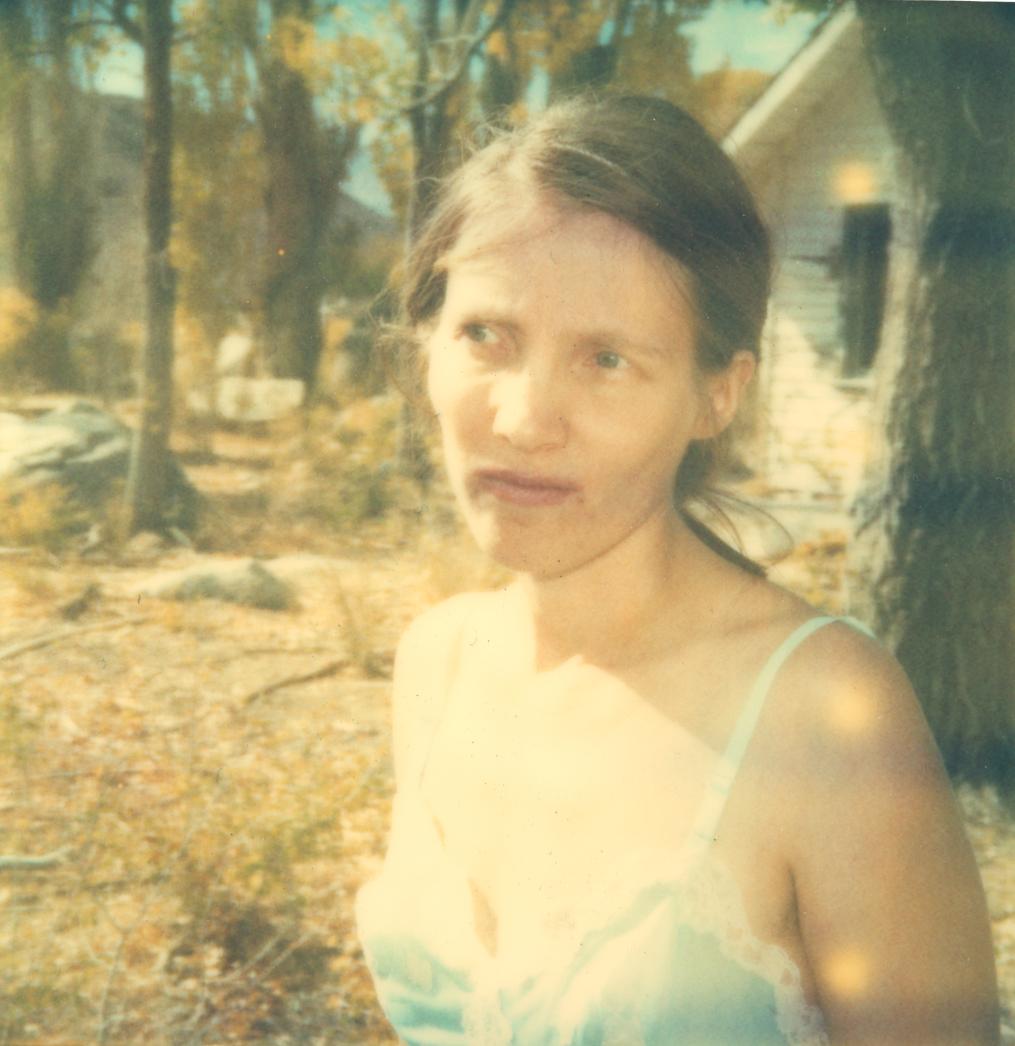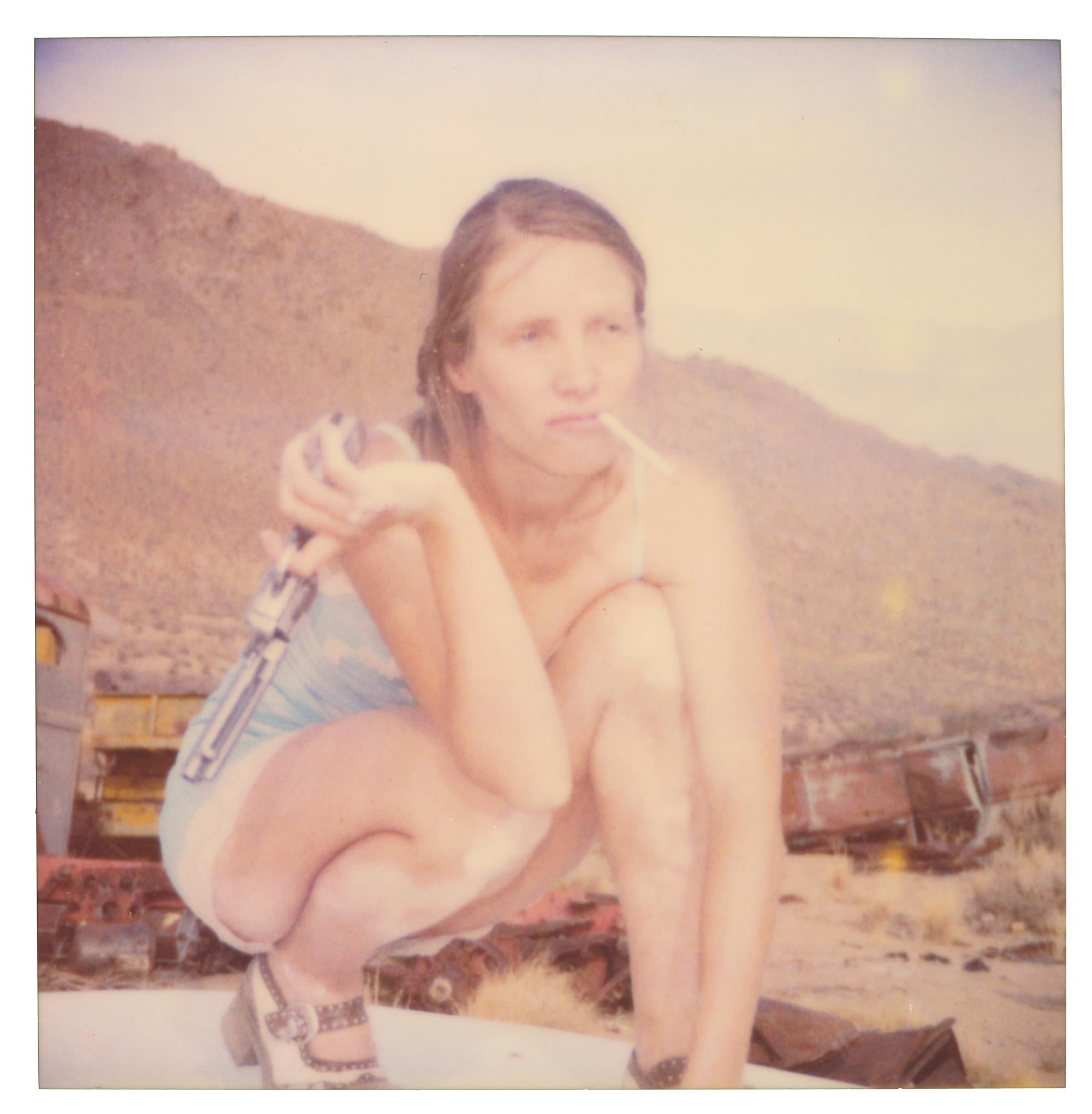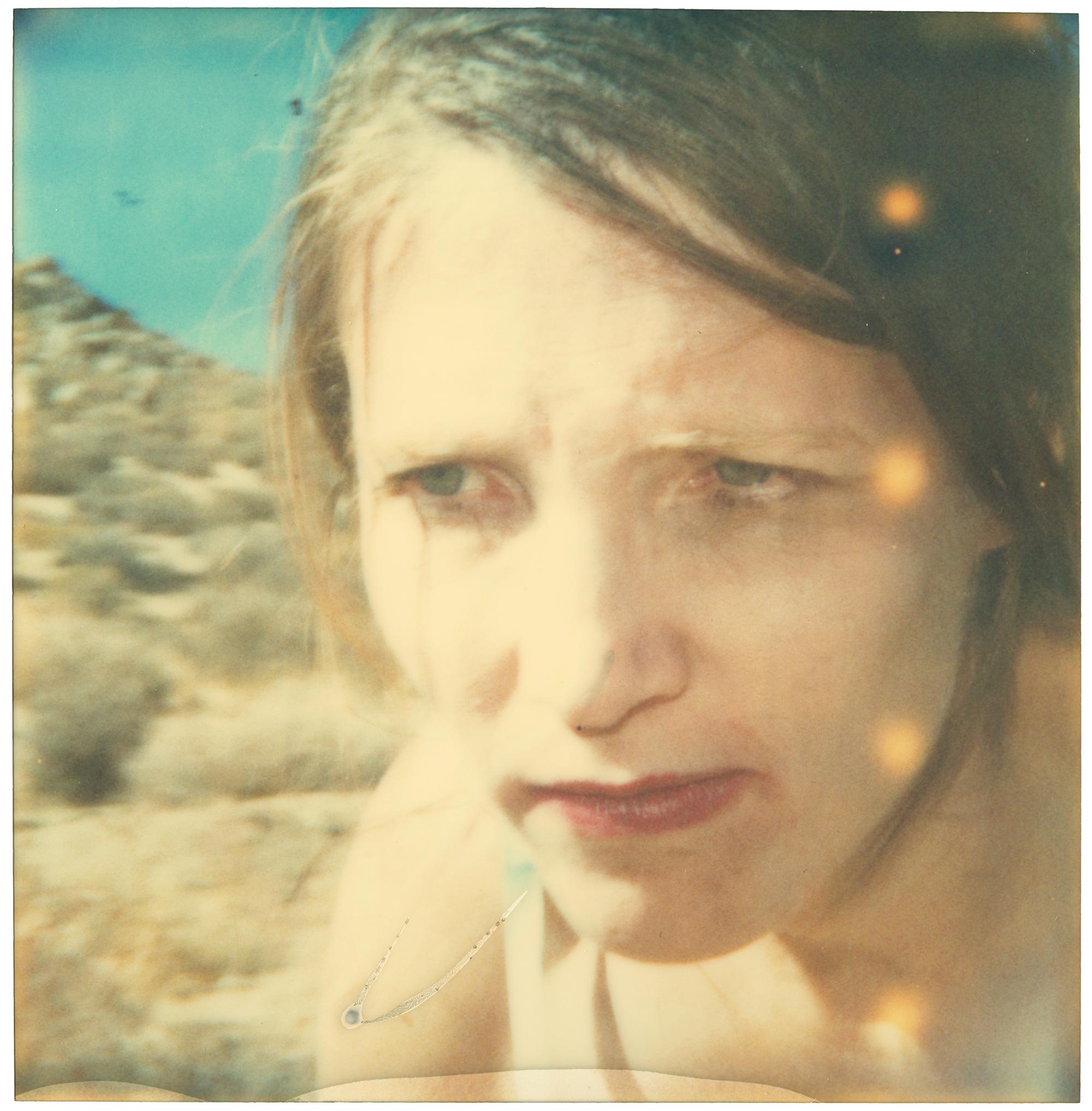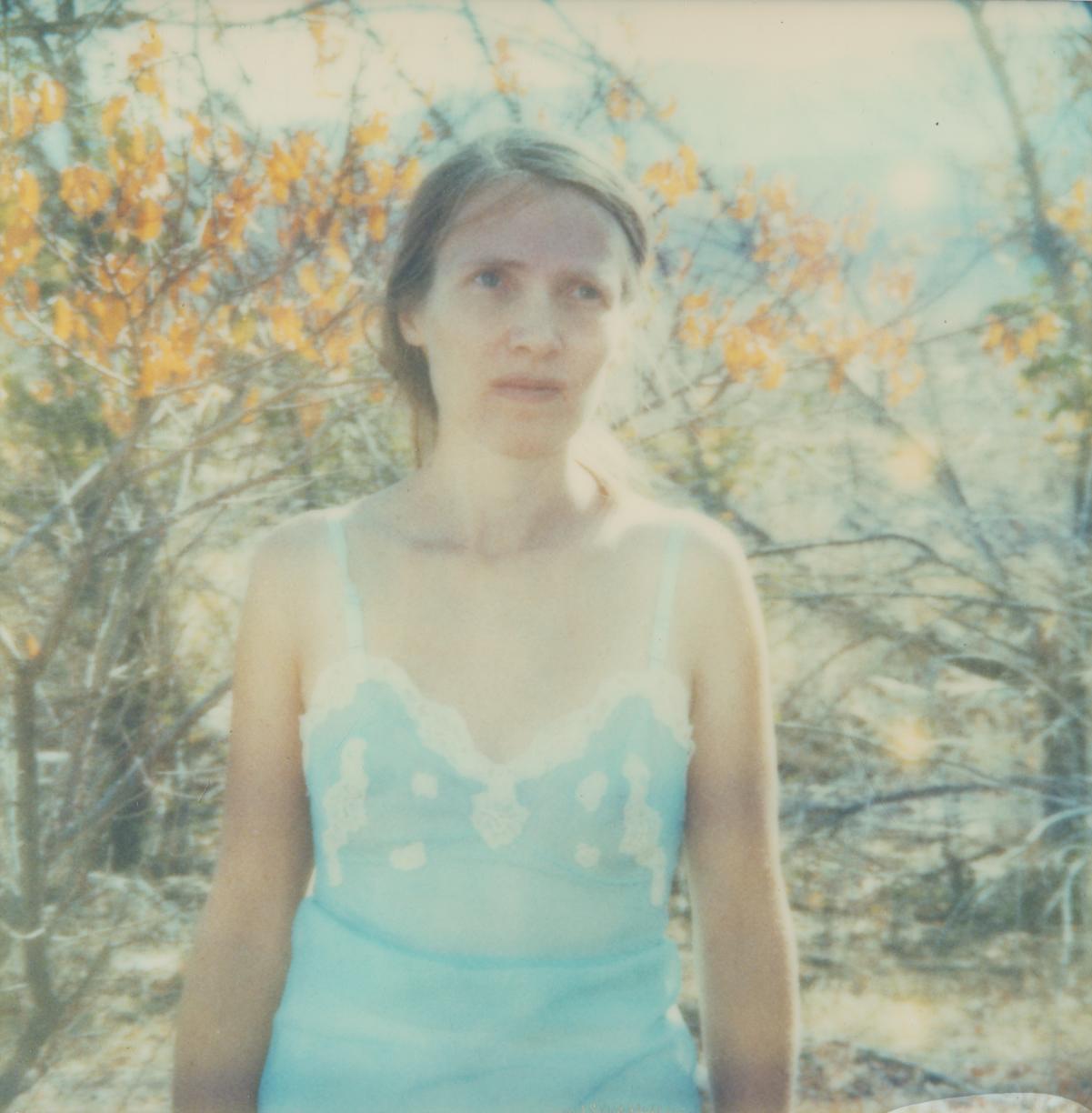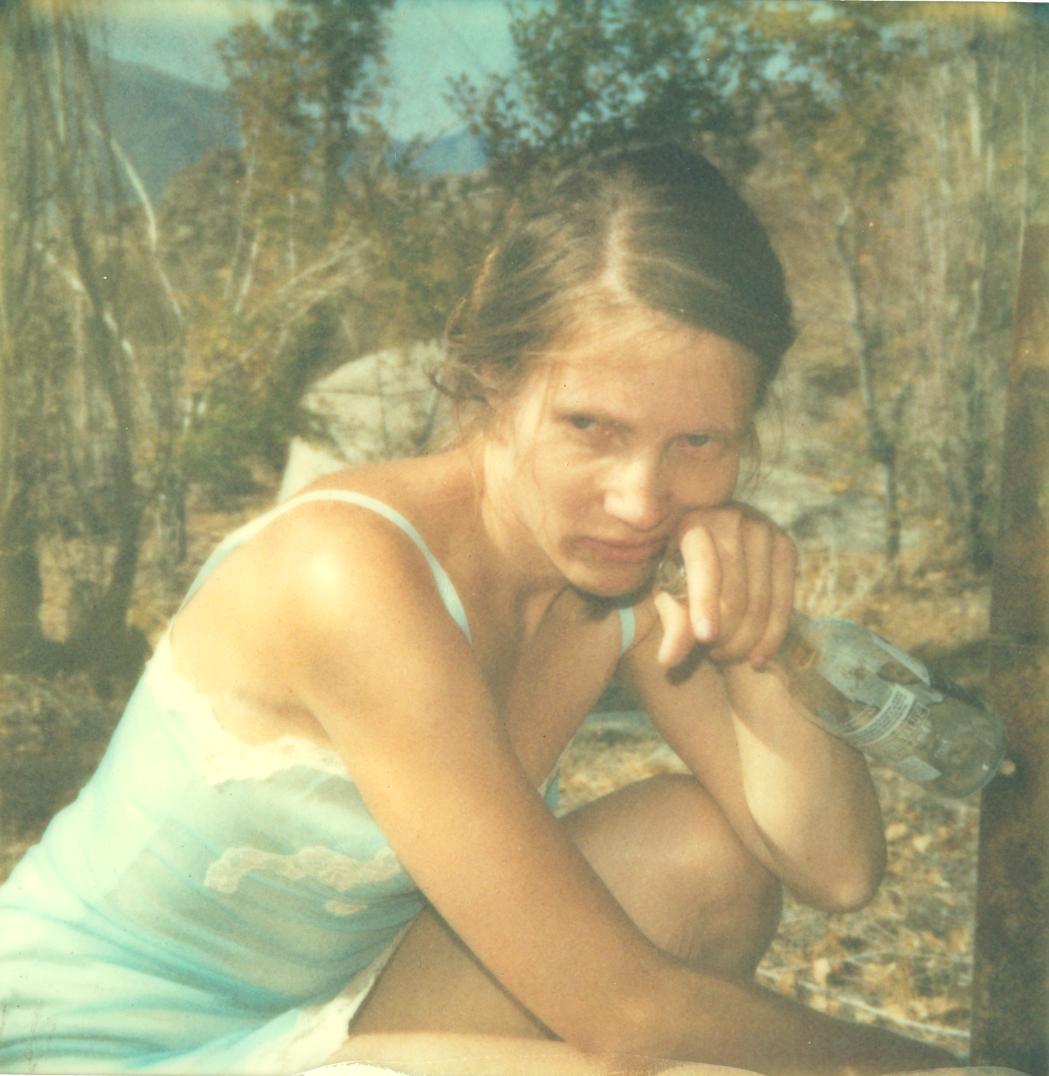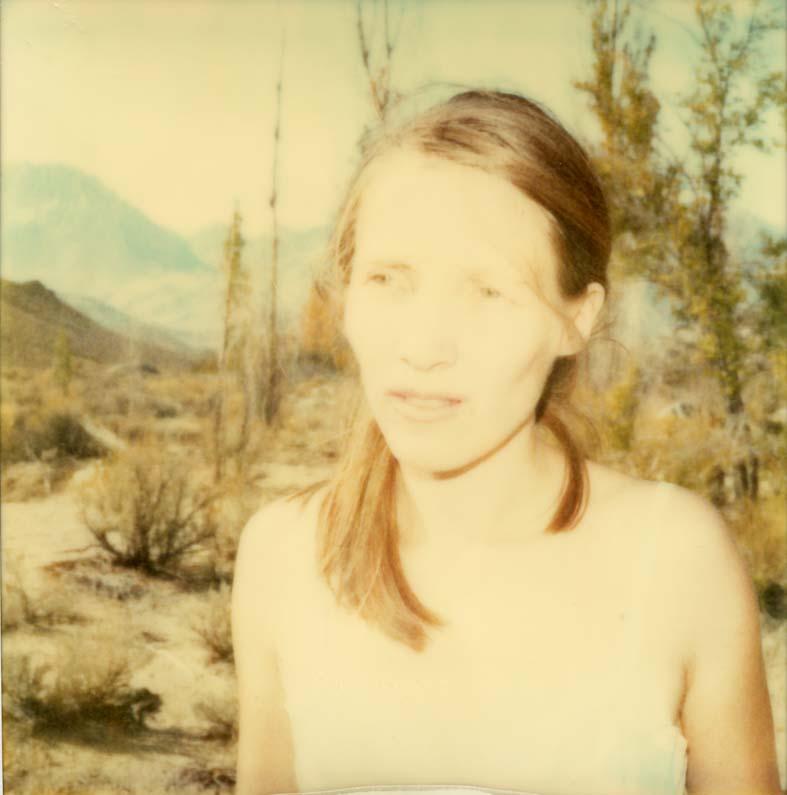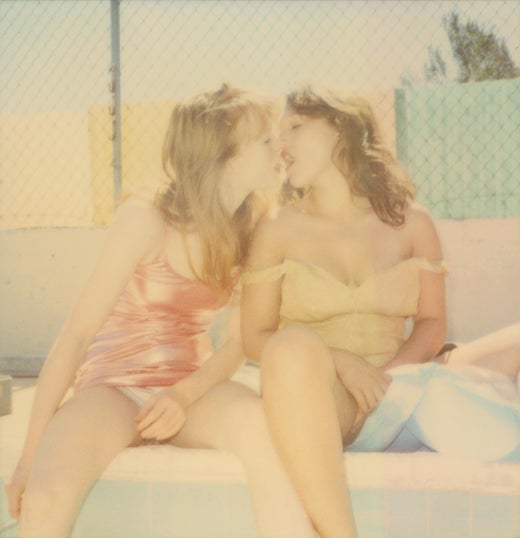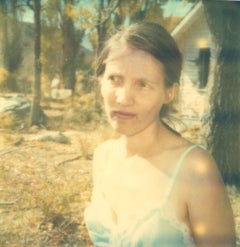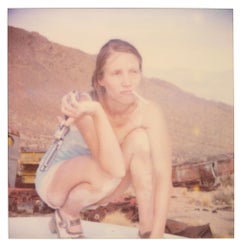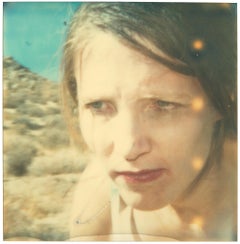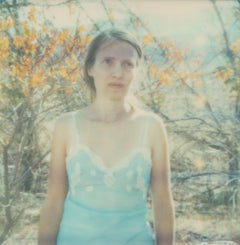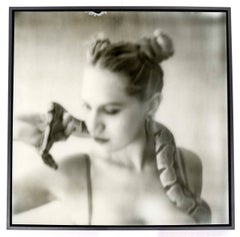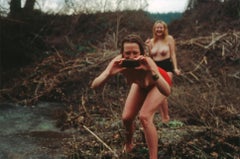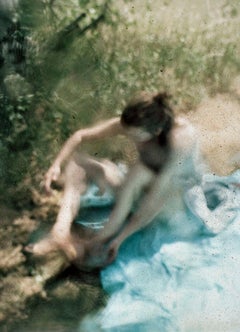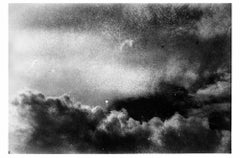Items Similar to Wits End (Wastelands) - Contemporary, Analog, Polaroid, Color
Want more images or videos?
Request additional images or videos from the seller
1 of 2
Stefanie SchneiderWits End (Wastelands) - Contemporary, Analog, Polaroid, Color2003
2003
$380
£286.78
€328.31
CA$535.93
A$588.38
CHF 306.96
MX$7,120.22
NOK 3,847.26
SEK 3,625.13
DKK 2,450.78
About the Item
Wits End (Wastelands) - 2003
20x20cm,
Edition of 10 plus 2 Artist Proofs.
Archival C-Print, based on the original Polaroid.
Artist inventory Number 20496.
Signature label and Certificate.
Not mounted.
For sale is a piece from the Wastelands series.
Reality with the Tequila:
Stefanie Schneider’s Fertile Wasteland
by James Scarborough
“How much more than enough
for you for I for both of us darling?”
(E. E. Cummings)
Until he met her, his destiny was his own. Petty and inconsequential but still his own. He was cocksure and free, young and unaccountable, with dark hair and aquiline features. His expression was always pensive, a little troubled, but not of a maniacal sort. He was more bored than anything else. With a heart capable of violence.
Until she met him, she was pretty but unappreciated. Her soul had registered no seismic activity. Dustbowl weary, she’d yet to see better days. A languorous body, a sweet face with eyes that could be kind if so inclined.
Until she met him, she had not been inclined.
It began when he met her. She was struck in an instant by his ennui. The sum of their meeting was greater than the imbroglios and chicaneries of their respective existences. He was struck by the blank slate look in her eyes. They walked, detached and focused on the immediate, obscenely unaware of pending change across a terrain of mountainous desert, their eyes downcast and world-weary, unable to account for the buoyant feeling in her heart. His hard-guy shtick went from potentiality to ruse. The gun was not a weapon but a prop, a way to pass time. Neither saw the dark clouds massing on the horizon.
They found themselves alone in the expanses of time, unaware of the calamity that percolated even as they posed like school kids for the pictures. Happiness brimmed in that wild terrain. Maybe things were beginning to look up.
That’s when the shooting started…
Stefanie Schneider assumes that our experience of lived reality (buying groceries, having a relationship with someone, driving a car) does not correspond to the actual nature of lived reality itself, that what we think of as reality is more like a margarita without the tequila.
Stefanie Schneider’s reality is reality with the tequila. She does not abolish concepts that orient us, cause and effect, time, plot, and storyline, she just plays with them. She invites us to play with them, too. She offers us a hybrid reality, more amorphous than that with a conventional subject, verb, and predicate. Open-ended, this hybrid reality does not resolve itself. It frustrates anyone with pedestrian expectations but once we inebriate those expectations away, her work exhilarates us and even the hangover is good. An exploration of how she undermines our expectation of what we assume to be our lived reality, the reasons why she under- mines our expectations, and the end result, as posited in this book, will show how she bursts open our apparatus of perception and acknowledges life’s fluidity, its density, its complexity. Its beauty.
She undermines expectations of our experience of reality with odd, other-worldly images and with startling and unexpected compressions and expansions of time and narrative sequence. The landscape seems familiar enough, scenes from the Old West: broad panoramic vistas with rolling hills dotted with trees and chaparral, dusty prairies with trees and shrubs and craggy rocks, close-up shots of trees. But they’re not familiar. These mis-en-scenes radiate an unsettling Picasso Blue Period glow or the intense celestial blue of the cafe skies that Van Gogh painted in the south of France. Yellow starbursts punctuate images as if seen through the viewfinder of a flying saucer. At the same time, objects appear both vintage and futuristic, the landscape of a post-apocalyptic world.
Landscapes change seemingly at random as do the seasons. Stefanie Schneider offers no indication of how time flows here, except that it conceivably turns in on itself and then goes its merry way. Time is a river whose source is a deep murky spring which blusters about with an occasional swirling eddy.
That Stefanie Schneider thwarts an easy reading is obvious but why does she do this? Since she will not countenance anything linear, logical, or sequential, and because she does not relish anything concrete and specific, she has to roil things up a bit. Nor does she seem comfortable with a book of images that is settled, discrete, and accountable. Instead she wants to create a panoply of anxious moments that refuse to settle down into any predetermined reading. She seeks to assemble the elements, establish a provisional cosmology and then let each of us bring our own life experiences to bear on the enterprise. She unravels the paucity of a universe compromised by a matrix of either/or and replaces it with a kaleidoscopic neither/both cornucopia.
No fan of Descartes, she does not adhere to anything predicated on cogito ergo sum. No, the chance to present a universe of limitless iterations and utterances, open-ended, casualty-thwarting, intrigues her. She broaches a Heraclitan world: she shows that attempts to master, manage, and hoard time prove to be as elusive as a blind man trying to grab a salmon barehanded from a cold mountain stream. Even within the clear-cut parameters of the Old West universe onto which she gloms, she shows that time is a bandit, that it is a mirage, that it is as unpredictable as it is indefinable and infinite. She coaxes us, scene by scene a slow-motion, out-ofsequence film clip, to agree with her that a running moat of lived reality easily overwhelms a castle of rationality.
Stefanie Schneider does not mount a demolition effort much less a deconstruction one. Rather, she dismantles our expectations and sets about rebuilding not things but their connections anew. She is the mistress of the synapses. Indeed all these annoying ambiguities and irritating am- biances set the stage for a very particular certainty, one kernel of truth amidst these skewed and open-ended fields of inquiry. What connects all these images, in whatever order they might be presented1, is what I call an Augenblick, the mental distance between each page in whose ex- panse occurs the processing of shards of lived experience between these blinks of an eye that comprise the pages of Wastelands. During these innumerous Augenblicke, we take whatever shifts and turns that Stefanie Schneider throws at us, recalibrate our bearings, and then move on, at least until the next inevitable obstruction.
Irritating (and enlightening) as these shots may be, they’re nothing new. Rilke writes that, instead of trying to understand the quiddities of things, we should just be joyous at their mystery, just assume that they’re written in a lovely script that neither you nor anyone else can ever understand. Keats writes about being “awake forever in a sweet unrest,” although he’s talking about love. Stefanie Schneider makes us work for this idea of an Augenblick, but the result is worth it. The scenes and their sequencing dazzle us in a Borgesian Hall of Mirrors. Stefanie Schneider shows us that reality is anything but linear and user-friendly, but once one becomes accustomed to her enhanced dimension of space and time, we see the world in all its multifarious beauty and rapture. For that reason, Stefanie Schneider’s Augenblicke show us that reality may be a wasteland but it is as fertile as fertile can be.
1 I refer to Julio Cortazar’s novel, Hopscotch, in which he presents his story in a linear
way, with consecutive chapters that follow a particular coherence. In a note at the be-
ginning of the novel, he suggests an alternative reading via a new sequence of chapters.
So instead of reading chapter 1 first, chapter 2 second, you read, say chapter 57 first,
chapter 32 second, chapter 1 third and so on to form a new story. Similarly, Stefanie
Schneider’s Wastelands offers a multitude of coherences.
- Creator:Stefanie Schneider (1968, German)
- Creation Year:2003
- Dimensions:Height: 7.88 in (20 cm)Width: 7.88 in (20 cm)Depth: 0.04 in (1 mm)
- Medium:
- Movement & Style:
- Period:
- Condition:
- Gallery Location:Morongo Valley, CA
- Reference Number:1stDibs: LU652314609152
Stefanie Schneider
Stefanie Schneider received her MFA in Communication Design at the Folkwang Schule Essen, Germany. Her work has been shown at the Museum for Photography, Braunschweig, Museum für Kommunikation, Berlin, the Institut für Neue Medien, Frankfurt, the Nassauischer Kunstverein, Wiesbaden, Kunstverein Bielefeld, Museum für Moderne Kunst Passau, Les Rencontres d'Arles, Foto -Triennale Esslingen., Bombay Beach Biennale 2018, 2019.
About the Seller
4.9
Platinum Seller
Premium sellers with a 4.7+ rating and 24-hour response times
Established in 1996
1stDibs seller since 2017
1,041 sales on 1stDibs
Typical response time: 4 hours
- ShippingRetrieving quote...Shipping from: Morongo Valley, CA
- Return Policy
Authenticity Guarantee
In the unlikely event there’s an issue with an item’s authenticity, contact us within 1 year for a full refund. DetailsMoney-Back Guarantee
If your item is not as described, is damaged in transit, or does not arrive, contact us within 7 days for a full refund. Details24-Hour Cancellation
You have a 24-hour grace period in which to reconsider your purchase, with no questions asked.Vetted Professional Sellers
Our world-class sellers must adhere to strict standards for service and quality, maintaining the integrity of our listings.Price-Match Guarantee
If you find that a seller listed the same item for a lower price elsewhere, we’ll match it.Trusted Global Delivery
Our best-in-class carrier network provides specialized shipping options worldwide, including custom delivery.More From This Seller
View AllAfter (Wastelands) - Contemporary, Analog, Polaroid, Color
By Stefanie Schneider
Located in Morongo Valley, CA
After (Wastelands) - 2003
20x20cm,
Edition of 10 plus 2 Artist Proofs.
Archival C-Print, based on the original Polaroid.
Artist inventory Number 18799.
Signature label and Certi...
Category
Early 2000s Contemporary Color Photography
Materials
Archival Paper, Photographic Paper, C Print, Color, Polaroid
Posing I (Wastelands) - Polaroid, Expired. Contemporary, Color
By Stefanie Schneider
Located in Morongo Valley, CA
Posing I (Wastelands) - 2003
Edition of 5,
20x20cm,
Archival C-Print, based on the Polaroid.
Signature label and Certificate.
Artist Inventory No 1174.01
Not mounted.
Gaze upon S...
Category
Early 2000s Contemporary Portrait Photography
Materials
Archival Paper, Photographic Paper, C Print, Color, Polaroid
Insatiable (Wastelands) - Contemporary, Polaroid, 21st Cetury, Polaroid
By Stefanie Schneider
Located in Morongo Valley, CA
Insatiable - he came to my Valley (Wastelands)
Edition 2/5 , 57x56cm, 2003,
analog C-Print, hand-printed by the artist on Fuji Crystal Archive Paper,
based on a Polaroid.
Artist i...
Category
Early 2000s Contemporary Color Photography
Materials
Archival Paper, Photographic Paper, C Print, Color, Polaroid
It's Going to Be OK (Wastelands) - Contemporary, Analog, Polaroid, Color
By Stefanie Schneider
Located in Morongo Valley, CA
It's Going to Be OK (Wastelands) - 2003
20x20cm,
Edition of 10 plus 2 Artist Proofs.
Archival C-Print, based on the original Polaroid.
Artist inventory Number 23890.
Signature l...
Category
Early 2000s Contemporary Color Photography
Materials
Archival Paper, Photographic Paper, C Print, Color, Polaroid
Before (Wastelands) - Contemporary, Analog, Polaroid, Color
By Stefanie Schneider
Located in Morongo Valley, CA
Before (Wastelands) - 2003
20x20cm,
Edition of 10 plus 2 Artist Proofs.
Archival C-Print, based on the original Polaroid.
Artist inventory Number 18740.
Signature label and Cert...
Category
Early 2000s Contemporary Color Photography
Materials
Archival Paper, Photographic Paper, C Print, Color, Polaroid
Without You (Wastelands) - Contemporary, Analog, Polaroid, Color
By Stefanie Schneider
Located in Morongo Valley, CA
Without You (Wastelands) - 2003
20x20cm,
Edition of 10 plus 2 Artist Proofs.
Archival C-Print, based on the original Polaroid.
Artist inventory Number 934.
Signature label and Certificate.
Not mounted.
For sale is a piece from the Wastelands series.
Reality with the Tequila:
Stefanie Schneider’s Fertile Wasteland
by James Scarborough
“How much more than enough
for you for I for both of us darling?”
(E. E. Cummings)
Until he met her, his destiny was his own. Petty and inconsequential but still his own. He was cocksure and free, young and unaccountable, with dark hair and aquiline features. His expression was always pensive, a little troubled, but not of a maniacal sort. He was more bored than anything else. With a heart capable of violence.
Until she met him, she was pretty but unappreciated. Her soul had registered no seismic activity. Dustbowl weary, she’d yet to see better days. A languorous body, a sweet face with eyes that could be kind if so inclined.
Until she met him, she had not been inclined.
It began when he met her. She was struck in an instant by his ennui. The sum of their meeting was greater than the imbroglios and chicaneries of their respective existences. He was struck by the blank slate look in her eyes. They walked, detached and focused on the immediate, obscenely unaware of pending change across a terrain of mountainous desert, their eyes downcast and world-weary, unable to account for the buoyant feeling in her heart. His hard-guy shtick went from potentiality to ruse. The gun was not a weapon but a prop, a way to pass time. Neither saw the dark clouds massing on the horizon.
They found themselves alone in the expanses of time, unaware of the calamity that percolated even as they posed like school kids for the pictures. Happiness brimmed in that wild terrain. Maybe things were beginning to look up.
That’s when the shooting started…
Stefanie Schneider assumes that our experience of lived reality (buying groceries, having a relationship with someone, driving a car) does not correspond to the actual nature of lived reality itself, that what we think of as reality is more like a margarita without the tequila.
Stefanie Schneider’s reality is reality with the tequila. She does not abolish concepts that orient us, cause and effect, time, plot, and storyline, she just plays with them. She invites us to play with them, too. She offers us a hybrid reality, more amorphous than that with a conventional subject, verb, and predicate. Open-ended, this hybrid reality does not resolve itself. It frustrates anyone with pedestrian expectations but once we inebriate those expectations away, her work exhilarates us and even the hangover is good. An exploration of how she undermines our expectation of what we assume to be our lived reality, the reasons why she under- mines our expectations, and the end result, as posited in this book, will show how she bursts open our apparatus of perception and acknowledges life’s fluidity, its density, its complexity. Its beauty.
She undermines expectations of our experience of reality with odd, other-worldly images and with startling and unexpected compressions and expansions of time and narrative sequence. The landscape seems familiar enough, scenes from the Old West: broad panoramic vistas with rolling hills dotted with trees and chaparral, dusty prairies with trees and shrubs and craggy rocks, close-up shots of trees. But they’re not familiar. These mis-en-scenes radiate an unsettling Picasso Blue Period glow or the intense celestial blue of the cafe skies that Van Gogh painted in the south of France. Yellow starbursts punctuate images as if seen through the viewfinder of a flying saucer. At the same time, objects appear both vintage and futuristic, the landscape of a post-apocalyptic world.
Landscapes change seemingly at random as do the seasons. Stefanie Schneider offers no indication of how time flows here, except that it conceivably turns in on itself and then goes its merry way. Time is a river whose source is a deep murky spring which blusters about with an occasional swirling eddy.
That Stefanie Schneider thwarts an easy reading is obvious but why does she do this? Since she will not countenance anything linear, logical, or sequential, and because she does not relish anything concrete and specific, she has to roil things up a bit. Nor does she seem comfortable with a book of images that is settled, discrete, and accountable. Instead she wants to create a panoply of anxious moments...
Category
Early 2000s Contemporary Color Photography
Materials
Archival Paper, Photographic Paper, C Print, Color, Polaroid
You May Also Like
The Devil
By Victoria Goldman
Located in Hudson, NY
Listing is for UNFRAMED print. Inquire within for framing.
Edition of 22.
If the exhibition piece is sold or the customer orders a different print size, the photograph is produced upon purchase. Please allow two weeks for production.
Shipping time depends on method of shipping.
Price is subject to availability. The Robin Rice Gallery reserves the right to adjust this price depending on the current edition of the photograph.
ABOUT:
Victoria Goldman’s twenty-year-long fascination with Tarot has created a series of photographs based on the imagery and the mythology behind the ancient Tarot cards. Each image in the collection is inspired by and named after one of the 22 major archetypes of the Tarot. While photographing and teaching yoga and meditation in India, Hawaii, and throughout Europe, Goldman always made sure to carry a Tarot deck in her backpack. She views Tarot as a tool for personal elevation, helping her direct her focus and better understand her psyche.
The collection’s soft focus and figurative emphasis is reminiscent of the work of Francesca Woodman or Julia Margaret Cameron, whom Goldman cites as personal artistic inspirations. The concept behind the exhibition was long thought-out; while some pieces date as recently as two months prior to the exhibition opening, others date as far back as 1999 or 2000. Shot primarily with vintage Polaroid and film with a twin lens Rolleiflex camera, the dark, moody, mythological images recall a classical tone that mirrors the timelessness of the cards themselves.
The invitational image, entitled “Wheel of Fortune”, depicts a young woman in a glittering gown, her backside facing the viewer and her body positioned to spin a large carnival wheel hidden in the darkness of the photograph. The high-contrast nature of the image abstracts the gown, morphing the glitter on the dress into drops of light that shine through the dark air. The slender young woman in “Fortune” can be found in several of the collection’s photographs, depicting not just Lady Luck, as in the invitational image, but also the Emperor, the Devil...
Category
21st Century and Contemporary Color Photography
Something Real
By Sarah Elise Abramson
Located in Santa Monica, CA
Photography, edition 3/12.
Category
2010s Contemporary Nude Photography
Materials
Color
$200 Sale Price
20% Off
Untitled, from the series 'Coexistence' – Stephen Gill, Colour, Woman, Summer
By Stephen Gill
Located in Zurich, CH
Stephen GILL (*1971, Great Britain)
Untitled, from the series 'Coexistence‘, 2012
Canson Platine Fibre Rag 310 gsm
Image 54.6 x 36.5 cm (21 1/2 x 14 3/8 in.)
Sheet 60.9 x 45.4 cm (24...
Category
2010s Contemporary Color Photography
Materials
Archival Pigment
Expired_14_2020 - Photograph by Serena Zeppilli
Located in Roma, IT
This photograph Expired_14_2020 was taken by the Italian photographer Serena Zeppilli.
It is part of the series "I was looking for something that I...
Category
21st Century and Contemporary Contemporary Figurative Photography
Materials
Photographic Paper
Vintage 20X24 Format Polaroid Signed Surrealist Photograph Eve Sonneman Photo
By Eve Sonneman
Located in Surfside, FL
This is from a show at Sidney Janis Gallery and is from the estate of Joan Sonnabend.
Eve Sonneman (born in Chicago on 1946) is an American photographer and artist. She did a series ...
Category
1990s Contemporary Color Photography
Materials
Color, Polaroid
Secret Exhbitionist
By Sarah Elise Abramson
Located in Santa Monica, CA
Photography, edition 1/12.
Category
2010s Contemporary Nude Photography
Materials
Color
